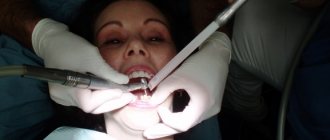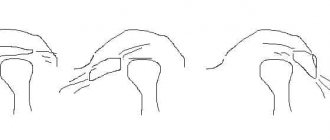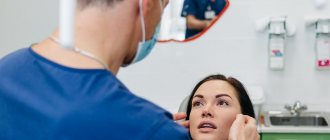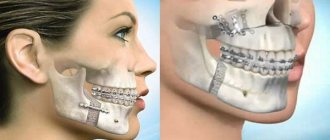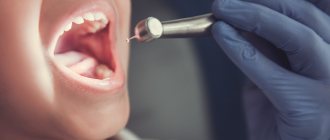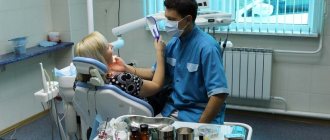Dentistry ARDC
The only branch of the American Clinic in Russia licensed by the Ministry of Health of the Russian Federation
Gnathology is a clinical area that deals with complex solutions to problems that arise at the intersection of dentistry and maxillofacial surgery. A gnathologist specializes in the diagnosis and treatment of diseases of the temporomandibular joint, masticatory muscles, as well as dental pathologies associated with malocclusions and complex dental prosthetics.
What is the scope of activity of a gnathologist?
Most of the unpleasant symptoms that relate to the dental system are associated with the development of diseases of the teeth and gums. However, this complex system also includes the facial and chewing muscles, jaw bones, TMJ, and nerve endings.
All of the above structural components of the dentofacial system play equally important roles in maintaining the full functioning of the dentofacial apparatus. It is the gnathologist who studies in detail the state of the constituent elements, the nature of their interaction, as well as the relationship of the structural components with other organs and systems.
The participation of a gnathologist in restorative dentistry is especially important. Unfortunately, during the restoration of lost teeth, not all clinics pay due attention to the condition of the muscles and joints of the dental system. This is why some patients, after completing restoration work, complain of discomfort when chewing, talking and smiling.
A notable feature of a gnathologist is its close relationship with other medical fields. The fact is that the science of gnathology was formed at the intersection of neurology, otolaryngology and other disciplines. A gnathologist works in tandem with orthopedists, orthodontists, and implantologists. Thanks to an integrated approach, the level of dental restoration is rapidly increasing.
Dentistry for those who love to smile
+7
Make an appointment
How is the initial appointment going?
An appointment with a maxillofacial surgeon begins with collecting an anamnesis and clarifying the range of complaints.
The doctor will ask the patient in detail about his well-being, conduct an examination and, based on the data obtained, prescribe a number of necessary studies that will provide the clearest picture of the problem. Based on the results of the examination, the doctor decides whether surgery is required, and if so, to what extent. Some pathologies, for example, cleft lip and palate, require several surgical procedures. The surgeon determines when to start treatment. If nearby organs and systems are involved in the pathological process, a related specialist (otolaryngologist, neurosurgeon, etc.) is involved in the examination and drawing up a therapeutic plan.
What does a gnathologist treat?
Analyzing all existing health problems, a gnathologist determines cause-and-effect relationships between phenomena and offers optimal treatment for such diseases:
- TMJ dysfunction, articular disc displacement;
- pathological occlusion;
- bruxism or generalized abrasion.
The specialist can determine the interalveolar height (the distance between the bone ridges of the jaws), restore the correct guidance of the jaw from below and recreate the correct incisal and canine separation.
If the lower jaw constantly cramps, only a gnathologist can determine the causes of the unpleasant phenomenon and plan a course of treatment for the dental apparatus. The specialist will plan muscle relaxation therapy using splints and a disconnecting mouthguard.
When is the help of a gnathologist needed?
Experts identify a number of typical symptoms that indicate the need to see a gnathologist. Among them:
- rapid fatigue of the masticatory muscles;
- muscle hypertonicity, which is felt during chewing;
- uncontrolled jaw clenching;
- localized or isolated pain in the masticatory muscles;
- discomfort when opening and closing the mouth;
- involuntary grinding of teeth (bruxism).
The progression of dysfunction of the mandibular nerve will be indicated by such obvious symptoms as clicking in the joint (occurs when chewing, opening and closing the mouth), joint block, displacement (the mouth opens in a zigzag or S shape). In the later stages of TMJ dysfunction, the patient complains of severe pain when chewing solid foods and the inability to fully open the mouth.
With problems with TMJ, patients report headaches, migraines, and stuffy ears. With pathology, not only the masticatory muscles hurt, but also the neck and occipital area. If the joint is dysfunctional, insomnia, snoring, dry mouth, and dizziness may occur.
If the described symptoms appear, you need to make an appointment with a gnathologist as soon as possible. If you ignore the problem, the improper functioning of the joint will gradually develop into irreversible degenerative processes and arthrosis.
Which doctor should I contact?
The first signs of the disease are often discovered by a dentist when visiting a patient for dental treatment or complaining of pain in the jaw. When palpating the jaw muscle, its compaction is noted, and the mobility of the joint is limited. To clarify the clinical picture, the doctor may prescribe conventional or contrast radiography, as well as a computed tomography examination. Depending on the results, treatment may require the participation of several specialists.
Treatment of arthrosis that has developed against the background of anatomical pathologies of the joint (bad bite, abrasion of teeth, absence of several adjacent lateral teeth) is carried out by dental doctors. A dental therapist, an orthodontist and a prosthetist can take part in the treatment.
If there is a history of diseases that provoke the development of arthrosis of the TMJ, the dentist may refer the patient to specialists of a different profile:
- If the cause is a disease associated with metabolic disorders, an endocrinologist is involved in the treatment.
- If nerve conduction disorders are detected, the help of a neurologist will be required.
- An infectious lesion of the maxillofacial joint or the presence of an inflammatory process localized in other joints (arthritis, rheumatism) is a reason to consult a rheumatologist.
- In some cases, with arthrosis of the TMJ, partial hearing loss is observed, then an otolaryngologist joins the complex treatment.
Why does TMJ dysfunction develop?
The reasons for the development of dysfunction can be very different - from the position of the teeth to pathologies that have nothing to do with dentistry. Pathological changes in the mandibular joint can be provoked by:
- variable changes in the psyche (neurosis, constant stress);
- problems with the autonomic nervous system (heart rate irregularities, blood pressure surges);
- parafunction of masticatory muscles;
- injuries in the TMJ area;
- episodic microtrauma of the joint caused by irrational or poor-quality prosthetics;
- traumatic occlusion;
- incorrect dental treatment (fillings that are too high);
The cause of TMJ dysfunction can also be untimely restoration of lost teeth, except for “eights”.
How is an appointment with a gnathologist?
An appointment with a gnathologist begins with a conversation with the patient and collection of anamnesis. Then the specialist conducts a visual examination, checks the closure of the teeth, evaluates the functioning of the muscular system, the position of the head and the severity of facial asymmetry. During the examination, the doctor places the main emphasis on the temporomandibular joint - assesses the TMJ in a stationary position and during functioning.
The gnathologist also studies other elements of the muscular-ligamentous apparatus - checks the degree of tension in the muscles of the neck, back, and posture of a person. These measures help the gnathologist make a presumptive diagnosis and identify therapeutic tactics.
Mandatory additional diagnostic methods are computer and hardware studies. The doctor determines the list of relevant ones in a particular clinical case. Possible:
- orthopantomogram, survey x-ray of the temporomandibular joint - allow us to identify pathologies in the development of bone tissue of the ligamentous apparatus;
- CT scan – helps the gnathologist examine the joint layer by layer and detect degenerative changes in the tissues;
- magnetic resonance imaging – necessary to assess the condition of the periarticular soft tissues and articular disc;
- axiography, hardware recording of the movement of the lower jaw and graphic diagnostics;
- analysis of occlusal contacts;
- diagnostic jaw models made of plaster.
In the topic of functional diagnostics, myography occupies a special place - a method for diagnosing the masticatory muscles and the quality of teeth closure.
Computer programs help speed up diagnosis and increase the effectiveness of treatment for TMJ dysfunction. They allow us to offer the most optimal ways to correct the system.
Gnathology
What is gnathology?
Gnathology is a science
that studies the effectiveness of the dental system in normal and pathological conditions.
Chewing is a vital function of processing and swallowing food. Gnathology - as a field of dentistry
, deals with the identification and treatment of pathology of the temporomandibular joint.
What does a gnathologist treat?
The most important element of the human masticatory apparatus is the paired
temporomandibular joint (TMJ). Movements of the lower jaw occur as a result of the complex interaction of the masticatory muscles, temporomandibular joints and teeth and are regulated by the neuromuscular system. The temporomandibular joint coordinates the movement of the lower jaw in three directions, and any movement occurs with simultaneous sliding and rotation of the heads of the lower jaw. During normal operation of the joint, painless opening and closing of the mouth is ensured by the intra-articular disc, which is a cartilage pad. Dysfunction of the temporomandibular joint (TMJ) interferes with proper chewing of food, speech formation,
and all this is accompanied by pain and a “clicking” of the joint when opening or closing the mouth.
The position of the jaw is disrupted, which leads to improper closure of the dentition. Any deviations in the functioning of the elements of the mandibular joint require competent consultation with a gnathologist. IMPORTANT: A gnathologist-dentist is engaged in functional diagnostics and treatment of dysfunctions of the temporomandibular joint (TMJ).
TMJ dysfunction leads to difficulties in diagnosis, as it has a variety of clinical manifestations. It is important to emphasize that a gnathologist as a specialist must have extensive practical experience in therapeutic and orthopedic dentistry. Incorrectly placed fillings, crowns and orthopedic structures in most cases are the root cause of pathology and a trigger for the malfunction of the dentofacial apparatus. As a specialist, a dentist orthopedic gnathologist will not only determine the cause and degree of dysfunction of the dentoalveolar system, but also propose an optimal treatment plan to eliminate them.
IMPORTANT:
If you need a highly professional consultation with a gnathologist, contact the Dentist dental clinic. Specialists with more than 17 years of experience will explain to you in detail and clearly the cause of your illness and offer a reasonable treatment plan.
Symptoms for which you should contact a gnathologist.
It is no secret that patients mostly turn to the dentist complaining of pain in the teeth. But how do you understand that pain and discomfort in the teeth and jaw are related to the joint? The first signs of dysfunction that you should pay attention to are:
- Rapid fatigue and muscle hypertonicity when chewing.
- Involuntary clenching of the jaws.
- Local or diffuse pain in the masticatory muscles.
- Discomfort when opening and closing the mouth.
- Bruxism (teeth grinding) Unconscious muscle activity not associated with chewing or speaking
Signs indicating the presence of TMJ dysfunction in the later stages:
- Clicking in the joint that occurs when opening the mouth, chewing, or yawning.
- Joint blocking and displacement. The mouth opens in a zigzag or S shape.
- Inability to chew solid food due to pain
- Limited mouth opening.
Patients report severe headaches, migraines of unknown etiology, congestion and tinnitus. Pain and muscle spasms not only in the masticatory muscles, but also in the muscles of the neck and occipital region. With joint dysfunction, dizziness, dry mouth, sleep disturbance, snoring, sleep apnea (breathing stops for 10 seconds) may also occur. IMPORTANT:
When such symptoms appear, treatment of TMJ by a gnathologist is mandatory. Otherwise, the incorrect functioning of the joint will eventually lead to the development of irreversible degenerative processes and immobilization (arthrosis).
Causes of TMJ dysfunction.
Overload of the masticatory apparatus is the basis of dysfunction, but there can be many reasons.
- Occlusal-articulatory
(closing of the dentition) the problem includes:
incorrect prosthetics, placement of flat fillings, single and multiple defects in the dentition,
pathological abrasion of teeth
, jaw injuries, malocclusion. All this is accompanied by a decrease (decrease) in the height of the bite. - Another problem is related to mechanical overload of the jaw muscles
and their spasm. Unilateral chewing, bruxism, and heavy speech load ultimately lead to chronic microtrauma of the elements of the TMJ. - And the third important factor is neuropsychic and physical stress
associated with changes in the activity of the central nervous system (CNS).
How does a gnathologist consultation work?
Consultation with a gnathologist-dentist is an important stage in the treatment of TMJ dysfunction and
begins with collecting complaints and anamnesis. Then the doctor proceeds to examine the oral cavity, assesses the closure of the teeth, the functioning of the muscular system, the position of the head, as well as the severity of facial asymmetry. Particular attention is paid to the temporomandibular joint, assessing it in a static position and when performing movements.
A gnathologist, who is maximally focused on obtaining the most effective treatment result, will study all the elements of the muscular-ligamentous apparatus of the neck area, the tension of the back muscles, and the patient’s posture. These elementary examination methods allow a competent specialist to quickly make a preliminary diagnosis and determine the scope of the examination and treatment tactics.
An obligatory part of diagnostics is computer and hardware research. From the variety of studies, the gantologist will select those necessary for treatment.
Often used in the practice of a gnathologist are:
- Orthopantomogram and plain radiograph of the TMJ, allowing to detect
abnormalities in the development of bone tissue of the ligamentous apparatus. - Computed tomography, which provides a layer-by-layer study of the condition of the joint and dystrophic changes.
- MRI of the joint has the greatest diagnostic value for studying the condition of the periarticular soft tissues and articular disc.
- Graphic research, axiography, method of recording movements of the lower jaw using a special apparatus;
- Analysis of occlusal contacts using an articulator device - a device that reproduces the movements of the lower jaw.
- Diagnostic plaster models of jaws.
Among functional diagnostics, myography is especially in demand - a method for studying the masticatory muscles, the quality of static and dynamic closure of teeth. There are other techniques: electromyography, phonoarthrography, gnathodynamometry. Modern computer programs help speed up the diagnostic process for TMJ lesions, as well as form a more accurate opinion about the mechanism of development of the pathological process. With their help, it is possible to offer optimal correction methods. All of the above methods evaluate the functioning of muscles and joints, determine exactly how the teeth close and help identify the cause of joint dysfunction.
IMPORTANT:
To ensure high quality diagnostics, all these methods can be used by gnathologists at the Dentist clinic.
What treatment methods are used.
Treatment carried out by a gnathologist usually involves an integrated approach. In the treatment of gnathological disorders, it involves the use of therapeutic and diagnostic devices.
- To restore the correct position of the jaw, use special
joint splints
. The technique is effective in combating bruxism, pathological tooth wear, and for relieving muscle tension in the maxillofacial and cervical region. - To stimulate the masticatory muscles of the face and neck, a high-tech system is used - a deprogrammer
. Designed specifically for use in neuromuscular dentistry and gnathology. This unique stimulator allows you to erase (deprogram) the masticatory muscle dysfunction reflex and restore normal tone. - If the dysfunction of the dentofacial apparatus is caused by poorly performed orthopedic treatment, with a serious decrease in the bite, then before repeated prosthetics, an individually made occlusal splint (splint)
, which has a lasting memory effect. Can be installed on one or two jaws at once. Splin not only corrects occlusion (closing), but also solves several functional problems. Evenly distributes the load when chewing, reduces the activity of the muscular system and thereby corrects the direction of movement of the lower jaw.
Dentist orthodontist-gnathologist.
Orthodontists recognize that most malocclusions are caused by problems other than dental problems. Most often, the development of orthodontic problems is caused by such anomalies as violation of the dimensions of individual elements of the jaw apparatus, deviations in the position of the jaws relative to the base of the skull, pathology of the temporomandibular joints or
chewing muscles. Cases of the development of malocclusion due to orthopedic problems of the spinal column are no exception. Malocclusion in 90% of cases is accompanied by pathological abrasion
, and consequently, a decrease in the height of the lower half of the face. Treatment with braces and aligners in such situations is useless and ineffective.
IMPORTANT: Orthodontic treatment cannot restore the previous volume of dental tissue in case of pathological abrasion, it cannot restore single and multiple defects in the dentition, and all this is directly related to dysfunction of the mandibular joint.
When, during a consultation, an orthodontist encounters existing disorders in the functioning of the maxillofacial apparatus, he is obliged to consult with a gnathologist-orthopedist. This will help to avoid mistakes and negative results after orthodontic treatment. If we objectively approach the problems of dysfunction, then an orthodontist-gnathologist
is not the best combination of specializations
. Since orthodontists, as specialized specialists, are very far from therapeutic and orthopedic dentistry and do not have sufficient knowledge and experience necessary for the effective treatment of TMJ dysfunction. The orthodontist corrects the abnormal position of the teeth in the jaw, improves the appearance of the dentition, and restores the correct closure of the dentition, but this is not enough to treat such a complex pathology.
IMPORTANT:
The specialists of the Dentist clinic are well aware that an interdisciplinary approach is very important and the orthodontist acts only as a specialist whose work is necessary in the intermediate stage of treatment of joint dysfunction.
Dentist orthopedist-gnathologist.
The gold standard or standard of a gnathologist is an orthopedic gnathologist.
In a broad sense,
If we consider the specialty of an orthopedist in dentistry, then this particular doctor is in charge of diagnosing and correcting defects of the musculoskeletal system. Having extensive experience in eliminating problems associated with the masticatory apparatus during prosthetics and deep knowledge in restoring its functions, this is an ideal candidate for a gnathologist.
The success of orthopedic treatment directly depends on the design of the prosthesis and its ability to evenly distribute the load during chewing. In this case, the condition of the temporomandibular joint and masticatory muscles is taken into account. Uniform distribution of the load and restoration of the correct bite height is the most important stage in the treatment of TMJ dysfunction.
Advantages of contacting specialists at the Dentist clinic.
By contacting the Dentist clinic on Chistye Prudy, each patient can count on a highly qualified consultation with an experienced gnathologist-orthopedist
. The center will be able to undergo examination using modern diagnostic methods, as well as carry out all stages of this treatment.
The advantages of the Dentist clinic are:
- High professional level of doctors in this profile.
- The ability to use advanced diagnostic and treatment methods, which will completely eliminate existing symptoms
- At the highest level, carry out orthopedic or orthodontic treatment for TMJ dysfunction.
The price for a consultation with a gnathologist in Moscow varies widely, and often does not correspond to the professional level of the specialist or the diagnostic capabilities of the center.
If you decide to make an appointment with a gnathologist-orthopedist at the Dentist clinic, you will be pleased to discover that, despite the high level of service, the consultation is free .
Differential diagnosis
Since the symptoms described above are similar to the manifestations of pathologies that are in no way related to gnathology, the doctor additionally conducts a differential diagnosis. A patient who comes to see a gnathologist may develop the following serious pathologies:
- myocardial infarction (pain radiates to the neck, lower jaw and shoulders);
- otitis media of unknown origin (severe jaw pain and hearing loss);
- cerebral circulatory disorders (dizziness, flashing “flies” before the eyes, nausea);
- thoracic and cervical osteochondrosis (pain is localized in the same areas);
- pinching of the facial nerve (unilateral hypertonicity of the facial muscles and tissue swelling);
- complications of pathologies of teeth and gums (inflammation and limitation of mobility of the lower jaw).
To exclude an error in diagnosis, the gnathologist carefully examines the patient’s medical history and identifies possible relationships between a person’s chronic diseases and the symptoms that appear.
How does TMJ arthrosis manifest?
Osteoarthritis of the maxillofacial joint can be caused by trauma, inflammation, the absence of a large number of teeth, or the use of dentures with poorly formed dentition. The causes of the development of pathology can also be metabolic disorders, connective tissue diseases or nerve conduction disorders.
Symptoms of arthrosis appear gradually as dystrophic changes develop. Most often patients complain of:
- aching pain that can radiate to the upper part of the skull - the area of the eyes or ears;
- characteristic crunching or clicking sounds that occur when the joint moves;
- decreased mobility of the bone joint, especially noticeable in the morning;
- displacement of the lower jaw to the right or left side from the center.
What treatment methods does a gnathologist use?
The therapy offered by a gnathologist is complex:
- To restore the correct position of the patient’s jaws, the specialist uses special joint splints. This tactic is justified if a person has bruxism, pathological tooth wear, muscle hypertonicity in the neck and maxillofacial region;
- To stimulate the masticatory muscles of the face and neck, the doctor uses a high-tech system - a deprogrammer. The development helps to deprogram the dysfunction reflex and bring the masticatory muscles to normal tone;
- in the treatment of joint dysfunction caused by poor-quality orthopedic therapy, a serious decrease in bite, the gnathologist uses an individual splint (splint) with a persistent memory effect. The device can be worn on either one or two jaws.
An individual occlusal splint not only corrects occlusion, but also copes with a number of functional tasks - evenly distributes the chewing load, reduces the activity of the masticatory muscles and corrects the direction of jaw movement from below.
What does the specialist treat?
An oral and maxillofacial surgeon diagnoses and treats the following pathological conditions:
- inflammation of the salivary glands;
- periodontitis;
- burns and wounds of the head and neck;
- periostitis;
- fracture of the bones of the facial skeleton (orbit, upper and lower jaw, zygomatic bone, nose);
- dislocation and subluxation of the jaw;
- cysts, tumors, fistulas of the salivary glands;
- osteomyelitis of the jaw;
- salivary stone disease;
- pathologies of the mandibular joint - arthritis, arthrosis, ankylosis, dysfunction of articular discs, etc.;
- abscess, phlegmon and other purulent lesions of the facial and cervical area;
- congenital defects (“cleft palate”, “cleft lip”);
- severe malocclusions that cannot be treated with orthopedic devices.
The GMS Hospital Surgical Center has everything required for conservative and surgical treatment of pathologies of the face and neck.
Our maxillofacial surgeons use advanced, low-traumatic methods and techniques, which makes it possible to achieve maximum clinical and aesthetic effects and significantly reduce rehabilitation time. Make an appointment We will be happy to answer any questions Coordinator Oksana
When is TMJ surgery performed?
If conservative therapy does not bring the desired results, a decision is made about the need for surgery on the temporomandibular joint. In such cases, the surgeon organizes one of the following types of interventions:
- TMJ puncture;
- removal of part of the pathological tissue, correction of the location of the cartilaginous disc and condyle;
- intra-articular surgery if a tumor process is diagnosed and bone tissue is destroyed.
The decision on the advisability of any operation is made by a medical council.
Dentistry for those who love to smile
+7
Make an appointment
What to expect after consulting a doctor
The specialist determines therapeutic tactics individually, based on the results of a comprehensive examination. Diseases or birth defects that do not require urgent intervention are treated in stages, with the involvement of related specialists (if necessary). The doctor will carry out all preoperative measures, set a date for surgery and hospitalization.
If damage to the facial and cervical area requires emergency surgical intervention, within an hour after treatment, the patient will already be operated on. In this case, the patient is immediately hospitalized and undergoes an urgent preoperative examination.
Gnathologist and orthodontist
Orthodontists often recognize the fact that bite pathologies in humans are very often caused not by dental problems, but by such anomalies as:
- disproportions in the sizes of individual elements of the dentofacial apparatus;
- incorrect position of the human jaws relative to the skull;
- pathologies of the temporomandibular joint;
- problems with the chewing muscles.
There are frequent cases of the development of bite pathologies due to orthopedic problems of the spinal column. 90% of clinical cases of abnormal dental occlusion are the subsequent development of pathological abrasion and a decrease in the height of the lower facial zone. It is not practical to solve emerging problems with braces and aligners.
If a patient has pathological abrasion, orthodontic therapy will not correct the situation and will not eliminate single and multiple defects in a row. This happens because dysfunction of the mandibular joint is to blame.
If, during the diagnosis, the orthodontist suspects that the patient’s problem is caused by disturbances in the functioning of the maxillofacial apparatus, he is obliged to refer the patient for a consultation with a gnathologist. This approach will avoid errors in diagnosis and speed up the patient’s recovery process.
If you approach the problem objectively and assume that an orthodontist will treat joint dysfunction, we can say with confidence that the result of therapy will be negative. Orthodontists are highly specialized specialists. They are far from gnathology and the peculiarities of the functioning of the temporomandibular joint. An orthodontist manages to cope with the abnormal arrangement of teeth in a row, improve the appearance of a smile, and restore the closure of teeth, but his knowledge and experience are not enough to cope with the pathology of the TMJ.
In what cases do you contact a gnathologist?
Regular toothache, tooth decay, or tooth extraction can be treated by a dentist or surgeon. A gnathologist solves many other health problems. Here are just some of the indications for which he is consulted:
- regular or constant pain in the neck and temples;
- pain in the back of the head and spine;
- clicking or aching pain in the jaw;
- discomfort or pain when chewing or closing teeth;
- pain when opening the jaw;
- increased wear of teeth and crowns;
- incorrect position of teeth;
- malocclusion and bruxism;
- articulation disorder;
- restriction of mouth opening;
- headaches/migraines
These and many other problems may be the result of a malfunction of the temporomandibular joint (TMJ), a disruption of its connections with the spine, bone or muscular skeleton.
During the examination, the following problems may be identified by a gnathologist:
- violation of the position of the articular disc;
- incorrect position of the jaws relative to the base of the skull;
- pathologies of the temporomandibular joints;
- pathologies of the masticatory or facial muscles;
- pathological changes in the shoulder and neck muscles;
- problems with the spine.
A visit to a gnathologist is often mandatory before orthodontic treatment or prosthetics to ensure an even chewing load on the teeth after installation of dentures or correction.
Orthopedist-gnathologist - “gold standard”
If we consider the specialty of an orthopedist in dentistry more broadly, we can say that his specialization includes the diagnosis and treatment of defects of the musculoskeletal system. An orthopedic doctor who already has good experience working with the masticatory apparatus and deep knowledge in restoring its functions using prosthetics becomes an ideal candidate for the role of a gnathologist.
When organizing proper orthodontic treatment, this is exactly the case - the doctor determines a prosthesis design that would evenly distribute the chewing load and additionally take into account the condition of the patient’s TMJ and his masticatory muscles. Proper distribution of the load during chewing and ensuring the correct bite height is the main stage in the treatment of temporomandibular joint dysfunction.
Preparation, diagnostics
To clarify or make a diagnosis, a wide range of studies is used:
- radiography;
- sialography;
- Ultrasound, CT, MRI;
- radiovisiography.
Also, to get the most complete picture, you will need to undergo a series of laboratory tests. The doctor determines what examinations will be needed in a particular situation during the initial appointment.
Forecast and prevention of joint dysfunction
The prognosis for treatment of joint dysfunction depends on the degree of pathological changes in the bone and cartilage, and the ligamentous apparatus of the TMJ.
At the initial stage of development of the disease, when there are no noticeable changes in the structure of the joint tissue, conservative treatment shows good results, which form a favorable prognosis for curing the disease.
If, at the time of seeking medical help, the patient has a significant loss of cartilage tissue, rupture or perforation of the intra-articular disc, as well as bone deformity, the prognosis is uncertain. In such cases, even after surgery to replace the articular disc, osteoplasty and other therapeutic measures, it is not always possible to fully restore the functionality of the TMJ.
Prevention of dysfunction is multifaceted. Primary preventive measures consist in the timely elimination of dental pathologies and dental anomalies. It is also worth working on existing bad habits (clenching your jaw during severe nervous tension, chewing on your hands, chewing on only one side, etc.). They stimulate the development of pathology. If the disease has developed against the background of psycho-emotional stress, it is also necessary to include psychological methods in prevention.
Secondary prevention of temporomandibular joint dysfunction involves preventing the rapid deterioration of the patient's condition and includes measures to prevent recurrent muscle spasms and the prevention of adhesions.
What operations does an oral and maxillofacial surgeon perform?
In the surgical center of the GMS clinic, almost the entire register of operations aimed at eliminating pathological conditions of the cervical and facial zone is performed. Our maxillofacial surgeons successfully perform the following interventions:
- surgeries for burns and wounds of the facial and cervical area;
- excision of a neck cyst;
- treatment of fractures of the facial skeleton;
- removal of oral cavity formations;
- surgery for jaw dislocation;
- cystectomy and cystotomy of the salivary glands;
- excision of a bone tumor (ameloblastoma, osteoma);
- removal of foreign objects from the maxillary sinus;
- bougienage and rinsing of salivary ducts;
- removal of stones from the salivary glands and their ducts;
- sclerosis of salivary gland cyst;
- endoprosthetics of the articular process and articular cavity of the lower jaw;
- plastic surgery of salivary ducts;
- opening and drainage of purulent foci of the facial and cervical zone;
- sequestrectomy;
- compression osteosynthesis.
The use of modern low-traumatic techniques allows us to minimize surgical trauma, while achieving maximum therapeutic and aesthetic results. An oral and maxillofacial surgeon quickly reconstructs and corrects a congenital or acquired defect of the facial or cervical area. At the same time, after the operation there will be no noticeable marks, scars or tissue scarring.
